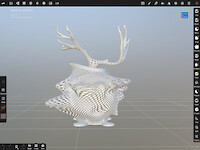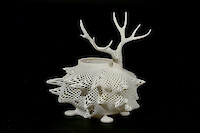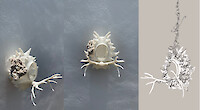Sentinel Species
Inspired by soft bodied organisms constructing external shells to protect their living spaces, our team looks into endangered birds that are threatened by complex urban landscapes. Focusing on reducing glass collision through 3D-printed structures that divert both migratory and non-migratory birds in our respective places. We aim to translate traditional craftsmanship by the birds in constructing their nests with our 3D printing approach that strengthen the structure for recurring usage by the birds.
Authors
LAU Tatia Pui Wan
YU Benedict
TURNBULL Josie
Description
Galvanised by diatoms, single-celled algae that extract silica from water to form highly intricate ‘glass houses’ to protect themselves, we considered them as a model organism in the context of threats to various bird species presented by urban architecture.
Just as ocean acidification causes ‘glitches’ in the formation of the protective shells of diatoms and other marine invertebrates, the soft bodies of both migratory and non-migratory birds are made vulnerable by human intervention and dissonant urbanisation.
In Singapore, the Pink-necked Green Pigeon (Treron Vernans), exemplifies the struggle multiple bird species contend with whilst navigating complex architecture which has only newly erupted - presenting a 95% loss of the island’s forest cover. As nomadic frugivores who have evolved to forage at forest edges, Pink necked green pigeons are particularly vulnerable, colliding into the deceptive, reflective glass facades that present as fatal obstacles.
Through research into existing solutions which aim to reduce collisions, and the design features needed for suitable manmade resting, nesting and feeding sites for foraging birds.
Combining existing strategies for reducing glass collisions - such as window decals, curtains of monofilament lines, shielded light fixtures, and anti-reflective window films, with a feeder mounted a maximum 1.5 foot from a glass window or pane, can reduce deaths.
To encourage extensive usage of our designs, we incorporated versatile mounting and hanging options - with ‘feet’ that can be stuck to multiple surfaces with the use of adhesive pads, and hoops which can be suspended from wall mounted brackets, trellises and tree branches. The feeders are designed with a good amount of air-ventilation and drainage. With our 3D SLA printed prototypes, we aim to magnify the intricacy of diatomic design to provide correspondingly thoughtful and diverse forms.








